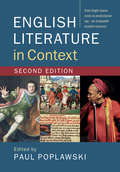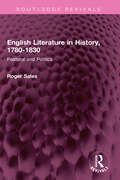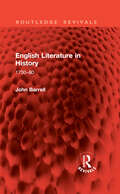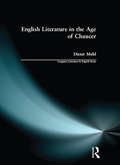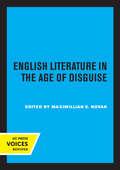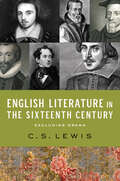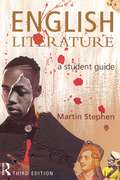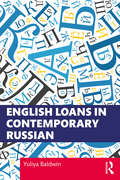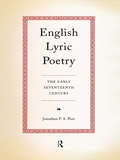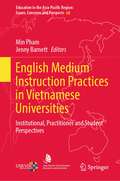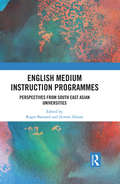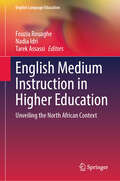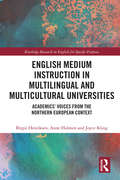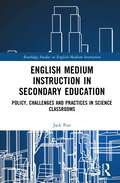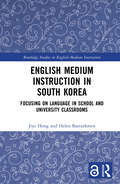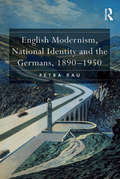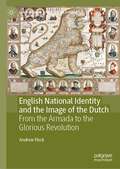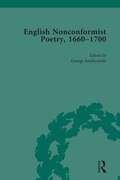- Table View
- List View
English Literature in Context (Second Edition)
by Paul Peter J. Andrew Hiscock Valerie Allen Lee Morrissey Kitson Maria Frawley Paul Poplawski John Brannigan PoplawskiSupporting the study of English literature from the Middle Ages to the present, this book is designed as an introductory text AND a helpful reference tool for an entire English Literature degree. Its key mission is to help students understand the link between the historical context in which the literature developed, how this has influenced the literature of the period and how subsequent periods in literature have been influenced by those that precede them. The book is carefully structured for undergraduate use, with a rich range of illustrations and textboxes that enhance and summarise vital background material. The seven chronological chapters are written by a team of expert contributors who are also highly experienced teachers with a clear sense of the requirements of the undergraduate English curriculum. Each analyses a major historical period, surveying and documenting the cultural contexts that have shaped English literature, and focusing on key texts. In addition to the narrative survey, each chapter includes a detailed chronology, providing a quick-reference guide to the period; contextual readings of select literary texts; and annotated suggestions for further reading.
English Literature in History, 1780-1830: Pastoral and Politics (Routledge Revivals)
by Roger SalesFirst published in 1983, English Literature in History, 1780-1830 is an original and provocative study of the literature of the Romantic period with an introduction by Raymond Williams. Roger Sales concentrates his analysis on two related themes. The first, the politics of pastoral, analyses the use of this genre by both established writers and poets who were enormously popular in their time, but who are now less well known. The author argues that all literary treatments of rural society in this period make political statements, particularly when they displace or disguise the economic facts of life. His second theme, the theatre of politics, introduces the reader to some of the main political events of the period, and demonstrates how their form and presentation can illuminate some of the literature of the period. This book will be of interest to students and teachers of English literature.
English Literature in History: 1730–80 (Routledge Revivals)
by John BarrellIn eighteenth-century Britain, the study of history was understood first and foremost as the study of how states developed—and lost—their political coherence. But at the same time, writers, preoccupied by contemporary social change, were coming to believe that economic progress was largely dependent on an ever-increasing variety of trades and occupations. Could this highly differentiated society still be understood as ‘unified’, and if so, by whom? Dr Barrell argues that these questions were of central importance not only to historians and social philosophers, but also to poets, novelists, essayists, and even writers of grammar and dictionaries.First published in 1983, English Literature in History examines how, in response to these questions, an economic theory of society was developed out of an earlier political view of society as an area of conflicting interests which could be regulated by disinterested statesmen and gentlemen. It shows how this new economic theory was perceived as a threat to the function and status of the gentleman, whose character had to be redefined if his authority was to be legitimated. Some of the ways in which this was achieved are traced in detailed analysis of the poetry of James Thomson and John Dyer, and in the novels of Tobias Smollett. A central chapter, focusing on Johnson’s Dictionary, demonstrates how notions of ‘correct’ English were used to confirm the status of the gentleman and to reinforce the authority of the ruling class.
English Literature in the Age of Chaucer (Longman Literature In English Series)
by Dieter MehlWritten in an engaging and accessible manner, English Literature in the Age of Chaucer serves as both a lucid introduction to Middle English literature for those coming fresh to the study of earlier English writing, and as a stimulating examination of the themes, traditions and the literary achievement of a number of particulary original and interesting authors. In addition to detailed and sensitive treatment of Chaucer's major works, the book includes chapters on his chief contemporaries, such as John Gower, William Langland and the Gawain-poet. It also examines the often underrated contribution to the English literary tradition of his successors John Lydgate and Thomas Hoccleve, as well as the interesting and original work of the Scottish poets, Robert Henryson, William Dunbar and Gavin Douglas, who also claim Chaucer as their model. Apart from the narrative poetry of Chaucer and his followers, the book also contains chapters on the Middle English lyric; Middle English prose, including Mandeville's travels; the most original and imaginative writings of the Middle English mystics, in particular Julian of Norwich and Margery Kempe; and Thomas Malory's impressive prose compilation of Arthurian stories.
English Literature in the Age of Disguise (Clark Library Professorship, UCLA)
by Maximillian E. NovakThis title is part of UC Press's Voices Revived program, which commemorates University of California Press’s mission to seek out and cultivate the brightest minds and give them voice, reach, and impact. Drawing on a backlist dating to 1893, Voices Revived makes high-quality, peer-reviewed scholarship accessible once again using print-on-demand technology. This title was originally published in 1977.
English Literature in the Sixteenth Century (Excluding Drama)
by C. S. LewisC. S. Lewis offers a magisterial take on the literature and poetry of one of the most consequential periods in world history, providing deep insight into some of the greatest writers of the age, including Edmund Spenser, William Shakespeare, William Tyndale, John Knox, Dr. Johnson, Richard Hooker, Hugh Latimer, Christopher Marlowe, John Donne, and Thomas Cranmer.English Literature in the Sixteenth Century is an invigorating overview of English literature from the Norman Conquest through the mid-seventeenth century from one of the greatest public intellectuals of the modern age. In this wise, distinctive collection, C. S. Lewis expounds on the profound impact prose and poetry had on both British intellectual life and his own critical thinking and writing, demonstrated in his deep reflections and essays. This incisive work is essential for any serious literature scholar, intellectual Anglophile, or C. S. Lewis fan.
English Literature: A Student Guide
by Martin StephenNow appearing in its third edition, Martin Stephen's classic text and course companion to English literature has been thoroughly revised and updated, taking account of the changes which have occurred in the subject since publication of the second edition.
English Loans in Contemporary Russian
by Yuliya BaldwinEnglish Loans in Contemporary Russian presents over 2,000 English borrowings in the Russian lexicon, providing a unique account of changes in the language and culture. The entries in this practical Russian-English dictionary cover a wide range of well-established loanwords to more recent neologisms. They address an increasingly relevant part of the contemporary Russian lexicon, particularly in the language of business, politics, mass media, computer, medicine, and other professional areas. The dictionary reflects how the language is responding to new patterns of life and will be of interest to Russian language learners and linguists.
English Loanwords in Japanese
by Akira MiuraToriningu-pantsu are not training pants for babies who have not yet been toilet-trained. Toreningu-pantsu are sweat pants. When you jump into a swimming pool you will get wet, but not necessarily uetto. Volleyball, which was invented in the United States, is known as bareboru in Japan, but the tennis volley was the English gentleman's pride before it was America's . A tennis volley is therefore pronounced in British style, bore, not as American bare. Oru means "all" but has a more limited usage. Bosu is often used more negatively than English boss.Many people imagine that speakers of English who study the Japanese language find their way eased by the profusion of "English words" the Japanese have borrowed. Students of the language, however, often complain that borrowed words are more problematic than the older terms in the Japanese word pool.One of the biggest problems is the lack of adequate reference materials on the terms. Many of the existing works do little more than define the terms. This book handles the problematic areas. Here a reader will find sample sentences, tips on usage, and warnings against easy-to-commit mistakes. There are fascinating studies of how certain "English" terms were coined in Japan and of what led the Japanese to redefine certain common English words. Miura examines how certain words entered Japanese, and why they became popular.He theorizes on why an unexpected pronunciation developed. In discussing the borrowed terms, the author draws on many linguistic scholars, discusses prevailing beliefs on etymology and pronunciation, and uses his own considerable experience with both English and Japanese to help the student gain control of some of the most problematic words borrowed by J apanese from English . Each of the 850 words discussed under the text's more than 350 main headings is included in a n index for quick reference. The detail and currency of the explanations contained in this book are unmatched by other books on the subject. For the student hard put to use these borrowed words, this text offers real help.
English Lyric Poetry: The Early Seventeenth Century
by Jonathan PostEnglish Lyric Poetry is a comprehensive reassessment of lyric poetry of the early seventeenth century. The study is directed at both beginning and more advanced students of literature, and responds to more specialised scholarly inquiries pursued of late in relation to specific poets. This extremely lucid and elegantly written book avoids the limitations of much recent criticism. Donne, Jonson, the Spenserians, Herbert, Milton, Marvell, Vaughan, as well as many non-canonical and women poets, all receive sustained, fresh, and detailed analysis. Jonathan Post seeks to assimilate many of the post-New Critical theoretical concerns with readings of the major and minor, male and female, authors of the period.
English Made Easy Student Workbook Level 8
by Shurley EnglishEnglish Made Easy Student Workbook Level 8
English Made Easy Student Textbook, Level 5
by Shurley Instructional MaterialsNIMAC-sourced textbook
English Made Easy, Student Textbook, Level 4
by Inc. Shurley Instructional MaterialsNIMAC-sourced textbook
English Medium Instruction Practices in Vietnamese Universities: Institutional, Practitioner and Student Perspectives (Education in the Asia-Pacific Region: Issues, Concerns and Prospects #68)
by Min Pham Jenny BarnettThis book focuses on English as a Medium of Instruction practices in higher education in Vietnam, addressing institutional, practitioner and student perspectives. It presents theoretical standpoints and empirical experiences of how institutional policies are enacted in the offering of English as a Medium of Instruction programs in universities in Vietnam, and how the disciplinary content is taught and learned through English. The book showcases the enactment of curricular and pedagogical practices in the classroom, drawing on a range of different disciplines central to university education. It also explores the roles of mother tongues in the construction of disciplinary knowledge in English as a Medium of Instruction programs and courses. This book provides guidance and practical information for university English as a Medium of Instruction policy makers, lecturers and student support teams in English for academic purposes across disciplines, as well as to the theoretical framing of the English as a Medium of Instruction field itself.
English Medium Instruction Programmes: Perspectives from South East Asian Universities
by Roger Barnard Zuwati HasimThis book is an exploration of the desirability and feasibility of English Medium Instruction (EMI) in specific university settings in South East Asia. There is an increasing trend in many universities in Asia, as elsewhere in the world, to introduce ‘international’ academic programmes taught through the medium of English. Despite the rapidity of this development, there is a dearth of empirical research that investigates the opportunities and challenges across a range of specific contexts. This volume intends to occupy this research space, firstly by reviewing historical and contemporary trends and changes to EMI, and by eliciting the perceptions of a number of applied linguists in a range of Asian universities. These introductory chapters are followed by three case studies exploring the beliefs and practices of EMI lecturers in Malaysia, Brunei and Indonesia, and a survey of Malaysian students’ attitudes to key issues relating to medium of instruction. Based on these empirical studies, implications will be drawn with regard to policy, curricula, pedagogical practice, professional development and further research. This book will provide guidance for decision-makers and practitioners for the effective planning and implementation of EMI programmes where English is an additional language for lecturers and students.
English Medium Instruction as a Local Practice: Language, culture and pedagogy (SpringerBriefs in Education)
by Jinghe HanFrom the perspective of translanguaging and instruction theories, this Open Access book examines Chinese English Medium Instruction (EMI) lecturers’ linguistic and pedagogical characteristics. This book demonstrate that ‘English’ in EMI is not a monolingual issue and EMI lecturers have applied their bilingual advantages to systematically and strategically advance their pedagogy practices through a translanguaging process. This book reflects upon EMI lecturers’ culture-imbedded teaching and learning philosophies and explores the implications of local classroom practices, such as topic-centered instruction and teacher presentation through demonstration. This book argues that EMI teaching is not an approach that can reach universal consent across linguistic, cultural and educational systems; it is an approach that is exclusively contextualised in the lecturers’ closely related cultural and educational system, and restricted by the available resources.This is an open access book.
English Medium Instruction in Higher Education: Unveiling the North African Context (English Language Education #44)
by Fouzia Rouaghe Nadia Idri Tarek AssassiThis book provides a thorough analysis of the implementation of English as a Medium of Instruction (EMI) in Higher Education (HE) institutions in the North African region. It examines the challenges and opportunities associated with EMI in Maghreb and Mashreq countries considering factors like language proficiency, teaching methods, and the attitudes of both students and teachers towards using English as a medium of instruction. The book also explores the historical, cultural, and linguistic contexts that have influenced language ideologies in these countries and their impact on the adoption of EMI policies. It raises questions about the role and status of particular languages and how these impact the reception and implementation of EMI in various contexts. This book contributes to understanding language policy and planning, providing valuable insights for academics, educators, policymakers, and scholars with an interest in the region. It is also useful for academics, teachers and policymakers worldwide.
English Medium Instruction in Multilingual and Multicultural Universities: Academics’ Voices from the Northern European Context (Routledge Research in English for Specific Purposes)
by Birgit Henriksen Anne Holmen Joyce KlingEnglish Medium Instruction in Multilingual and Multicultural Universities analyses the issues related to EMI at both a local and international level and provides a broad perspective on this topic. Drawing on field studies from a Northern European context and based primarily on research carried out at the University of Copenhagen, this book: introduces a topical global issue that is central to the higher education research agenda; identifies the issues and challenges involved in EMI in relation to central linguistic, pedagogical, sociolinguistic and socio-cultural concepts; captures university lecturers’ experiences in the midst of curricular change and presents reflections on ways to navigate professionally in English to meet the demands of the multilingual and multicultural classroom. English Medium Instruction in Multilingual and Multicultural Universities is key reading for researchers, pre- and in-service teachers, university management, educational planners, and advanced students with an interest in EMI and the multilingual, multicultural university setting.
English Medium Instruction in Secondary Education: Policy, Challenges and Practices in Science Classrooms (Routledge Studies in English-Medium Instruction)
by Jack PunJack Pun presents best practices in pedagogy and teaching to facilitate effective content-subject learning at the secondary school level.Increasingly, parents are sending their children to English Medium Instruction (EMI) secondary schools in their home countries, to prepare them for full immersion in EMI in English native-speaking countries. The book explores the teaching and learning processes in EMI senior secondary science classrooms based in thirty secondary schools in Hong Kong. Conducting analyses of classroom, teacher and student perception data, the author discusses the issues of teaching science through the medium of English in secondary schools, the implications and applications for professional development of science teachers and other content-subject teachers, and suggests strategies for teaching science in different EMI contexts.This volume is highly relevant to scholars in the field of educational linguistics, particularly in English language teaching, content-based instruction, content and language integrated learning, and English as a medium of instruction. It is also useful to education policymakers, school teachers, research students, English and education majors.
English Medium Instruction in South Korea: Focusing on Language in School and University Classrooms (Routledge Studies in English-Medium Instruction)
by Helen Basturkmen Jiye HongAdding to the growing body of research on English Medium Instruction (EMI), this book focuses on the language support systems currently used by EMI mathematics and social science schoolteachers and university lecturers in South Korea.While EMI is an instructional field, there is a gap in the knowledge of how teachers and lecturers integrate English language-specific practices within their curriculum. Drawing on findings from an observational and interview-based case study at secondary and tertiary levels in South Korea, the research outlines differing planned teaching practices and illustrates EMI classroom interaction, language-related episodes (LREs) in this interaction, and vocabulary materials developed by EMI teachers and lecturers. Hong and Basturkmen discuss how they assessed the students’ learning from LREs in classroom interaction and the results from these findings, which illustrate practical advice and guidelines for integrating a focus on language into the discipline of teaching. The volume also offers several application tasks, including two reflection-on-practice projects, which the reader can try out by using the procedures developed in the case study.This is the first major book-length examination of EMI in the South Korean context and presents a useful resource for EMI teachers, lecturers, and educators – in South Korea and globally – who are looking to develop their methodology for language, including practical suggestions about how to seamlessly incorporate the learning of disciplinary vocabulary and forms of expression using EMI.
English Modernism, National Identity and the Germans, 1890–1950
by Petra RauThis is the first systematic study to trace the way representations of 'Germanness' in modernist British literature from 1890 to 1950 contributed to the development of English identity. Petra Rau examines the shift in attitudes towards Germany and Germans, from suspicious competitiveness in the late Victorian period to the aggressive hostility of the First World War and the curious inconsistencies of the 1930s and 1940s. These shifts were no simple response to political change but the result of an anxious negotiation of modernity in which specific aspects of Englishness were projected onto representations of Germans and Germany in English literature and culture. While this incisive argument clarifies and deepens our understanding of cultural and national politics in the first half of the twentieth century, it also complicates current debates surrounding race and 'otherness' in cultural studies. Authors discussed include major figures such as Conrad, Woolf, Lawrence, Ford, Forster and Bowen, as well as popular or less familiar writers such as Saki, Graham Greene, and Stevie Smith. Accessibly written and convincingly argued, Rau's study will not only be an important book for scholars but will serve as a valuable guide to undergraduates working in modernism, literary history, and European cultural relations.
English National Identity and the Image of the Dutch: From the Armada to the Glorious Revolution (Early Modern Literature in History)
by Andrew FleckThis book makes newly visible the sustained engagement of the English and the Dutch throughout a critical century in their cultural and national development. It reads a broad selection of early modern literary texts, some never before treated in Anglophone scholarship, in which the Dutch and the English wrote about each other and themselves. This interdisciplinary study brings to light the key affinities of these two nations: their embrace of liberty, turn toward Protestantism, and pursuit of commerce. It shows that as Catholic, colonial powers worked to prevent the rise of early modern Europe’s two great Protestant states, those similarities—as well as a combination of English admiration, envy, and distrust of the Dutch—produced an emulous rivalry that remade the two nations and their literature.
English Nonconformist Poetry, 1660-1700, vol 1
by George SouthcombeThe multi-faceted nature of dissenting verse is demonstrated, from the sonnets of the Quaker Martin Mason to the self-consciously 'witty' acrostic used to commemorate the Fifth Monarchist Vavasor Powell's death, to the Quaker schismatic John Perrot's 'A sea of the seed's sufferings'.
English Nonconformist Poetry, 1660-1700, vol 2
by George SouthcombeThe multi-faceted nature of dissenting verse is demonstrated, from the sonnets of the Quaker Martin Mason to the self-consciously 'witty' acrostic used to commemorate the Fifth Monarchist Vavasor Powell's death, to the Quaker schismatic John Perrot's 'A sea of the seed's sufferings'.
